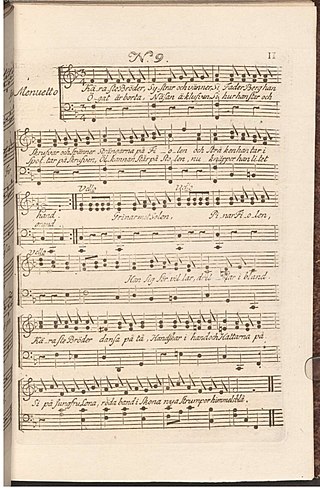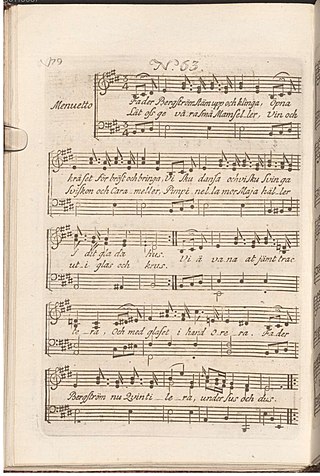
Fredmans epistlar is a collection of 82 poems set to music by Carl Michael Bellman, a major figure in Swedish 18th century song. Though first published in 1790, it was created over a period of twenty years from 1768 onwards. A companion volume, Fredmans sånger was published the following year.

Märk hur vår skugga is one of the best-known of the 1790 Fredman's Epistles, where it is No. 81. These were written and performed by Carl Michael Bellman, the dominant figure in the Swedish song tradition. Its subject is the funeral of one of Bellman's female acquaintances, Grälmakar Löfberg's wife.

Solen glimmar blank och trind is Epistle No. 48 in the Swedish poet and performer Carl Michael Bellman's 1790 song collection, Fredman's Epistles. The Epistle is subtitled "Hvaruti afmålas Ulla Winblads hemresa från Hessingen i Mälaren en sommarmorgon 1769". One of his best-known and best-loved works, it depicts an early morning on Lake Mälaren, as the Rococo muse Ulla Winblad sails back home to Stockholm after a night spent partying on the lake. The composition is one of Bellman's two Bacchanalian lake-journeys, along with epistle 25, representing a venture into a social realism style.

Hvila vid denna källa is a song by the Swedish poet and performer Carl Michael Bellman from his 1790 collection, Fredman's Epistles, where it is No. 82, the final Epistle. It is subtitled "Eller Oförmodade avsked, förkunnat vid Ulla Winblads frukost en sommarmorgon i det gröna. Pastoral dedicerad till Kgl. Sekreteraren Leopoldt" . It depicts the Rococo muse Ulla Winblad, as the narrator offers a "little breakfast" of "red wine with burnet, and a newly-shot snipe" in a pastoral setting in the Stockholm countryside.

Ack du min moder, originally written Ach! du min Moder, is one of the Swedish poet and performer Carl Michael Bellman's best-known and best-loved songs, from his 1790 collection, Fredman's Epistles, where it is No. 23. The collection is ostensibly of drinking-songs, but they vary in character from laments to pastorales, often simultaneously realistic and elegantly rococo in style. The song has two parts, despairing and celebratory: it begins as a lament, with Jean Fredman lying drunk in a Stockholm gutter outside the Crawl-in tavern, and repeatedly cursing his mother for conceiving him. Then he goes in, is revived by a stiff drink, and repeatedly thanks his mother and father for his life.

Käraste Bröder Systrar och Vänner is Epistle No. 9 in the Swedish poet and performer Carl Michael Bellman's 1790 song collection, Fredman's Epistles. The epistle is subtitled with the dedication "Til Gumman på Thermopolium Boreale och hännes Jungfrur.", Barbara Ekenberg. It describes the fictional Jean Fredman's cheerful world of brandy, women, and dance, in the setting of a tavern which is halfway to a brothel. The song ends with Fredman's credo, a celebration of everything that is delightful in life.

Blåsen nu alla, "All blow now!", is one of the Swedish poet and performer Carl Michael Bellman's best-known and best-loved songs, from his 1790 collection, Fredman's Epistles, where it is No. 25. It is a pastorale, based on François Boucher's rococo 1740 painting Triumph of Venus.

Glimmande Nymf! blixtrande öga!, is a song by the Swedish poet and performer Carl Michael Bellman from his 1790 collection, Fredman's Epistles, where it is No. 72. It is subtitled "Lemnad vid Cajsa Lisas Säng, sent om en afton", and set to a melody by Egidio Duni. A night-piece, it depicts a Rococo muse in the Ulla Winblad mould, asleep in her bed in Stockholm, complete with allusions to both classical and Nordic mythology.

Liksom en Herdinna, högtids klädd, is a song by the Swedish poet and performer Carl Michael Bellman from his 1790 collection, Fredman's Epistles, where it is No. 80. The Epistle is subtitled "Angående Ulla Winblads Lustresa til Första Torpet, utom Kattrumps Tullen". It is a pastorale, starting with a near-paraphrase of Nicolas Boileau-Despréaux's French guide to the construction of pastoral verse. That doesn't prevent the supposed shepherd and shepherdess from falling into bed drunk at the end of the song. It has been described as lovelier in Swedish than in Boileau's original French. The epistle's humorous depiction of the human condition has been praised by critics.

Vår Ulla låg i sängen och sov is Epistle No. 36 in the Swedish poet and performer Carl Michael Bellman's 1790 song collection, Fredman's Epistles. The epistle is subtitled "Rörande Ulla Winblad's flykt". It begins with the innkeeper peeping through the keyhole to her bedroom and whispering with his friends as she sleeps, slowly waking up. Then she dresses ornately and enters the tavern, delighting the menfolk until she is suddenly arrested.

I går såg jag ditt barn, min Fröja, is a ballad from the Swedish poet and performer Carl Michael Bellman's 1790 collection, Fredman's Epistles, where it is No. 28. The epistle is subtitled "Om et anstäldt försåt emot Ulla Winblad.". It describes an attempt to arrest the "nymph" Ulla Winblad, based on a real event. The lyrics create a rococo picture of life, blending classical allusion and pastoral description with harsh reality.

Käre bröder, så låtom oss supa i frid is Epistle No. 5 in the Swedish poet and performer Carl Michael Bellman's 1790 song collection, Fredman's Epistles. The epistle is subtitled "Til the trogne Bröder på Terra Nova i Gaffelgränden.". The first epistle to be written, it introduces Jean Fredman's fictional world of ragged drunken men in Stockholm's taverns, making music, drinking, and preaching the message of the apostles of brandy, in the style of St Paul's epistles. The composition's approach is simple compared to later epistles, retaining much of the character of a drinking song.

Gråt Fader Berg och spela is No. 12 in the Swedish poet and performer Carl Michael Bellman's 1790 song collection, Fredman's Epistles. The epistle is subtitled "Elegi över Slagsmålet på Gröna Lund". It is a lament over a pub brawl, caused by Fredman's drinking a soldier's beer and dancing with someone else's girlfriend. Set to the melody from the aria "The flocks shall leave the mountains" in George Frideric Handel's opera Acis and Galatea, it is the best-known of his poems describing the consequences of brandy-drinking. Bellman used the contrast between the romantic associations of the melody and the brutal reality of heavy drinking to humorous effect.

Movitz blåste en konsert is epistle No. 51 in the Swedish poet and performer Carl Michael Bellman's 1790 song collection, Fredman's Epistles. The epistle is subtitled "Angående konserten på Tre Byttor", naming a restaurant in Stockholm's Djurgården park. It was written after Bellman had become a court musician to the new King Gustav III in 1773. The melody was borrowed from George Frideric Handel's 1718 opera, Acis and Galatea.

Fader Bergström, stäm upp och klinga is one of the Swedish poet and performer Carl Michael Bellman's songs, from his 1790 collection, Fredman's Epistles, where it is No. 63. The melody is based on a minuet by Carl Envallsson. Bergström was a musician, and the song celebrates dancing and drinking late into the evening. The song, written in 1773, was revised heavily to make it suitable for publication. The initial version, naming Movitz not Bergström as the musician, was an attack on an over-zealous priest who had caused Bellman to be summonsed for an earlier poem that had joked about salvation. The song has been recorded by Bellman interpreters including Fred Åkerström, Fredrik Berg, and Rolf Leanderson.

Fram med basfiolen, knäpp och skruva is Epistle No. 7 in the Swedish poet and performer Carl Michael Bellman's 1790 song collection, Fredman's Epistles. The epistle is subtitled "Som synes vara en elegi, skriven vid Ulla Winblads sang, sent om en afton". It describes an attempt by Jean Fredman to make love to Ulla Winblad, set to a tune from a French operetta, narrated with a combination of biblical allusion and suggestive metaphor. The mention of elegy implies that the song is about death, but the subtext is of the "little death" or female orgasm. Scholars have remarked the epistle's ambiguity, enabling it to work both on a high mythological level and a low worldly level. Similarly, the musician's cello serves both as a musical instrument and as a symbol for Ulla Winblad's body, allowing the singer to mime plucking strings and feeling a woman's body.

Kära Syster is No. 24 in the Swedish poet and performer Carl Michael Bellman's 1790 song collection, Fredman's Epistles. The epistle is subtitled "Till kära mor på Bruna Dörren" ; its themes are drinking and death. One of his best-known works, it is set to a tune extensively modified from one by Egidio Duni for Louis Anseaume's 1766 song-play La Clochette. Bellman's biographer, Carina Burman, calls it a central epistle.

Värm mer Öl och Bröd is epistle No. 43 in the Swedish poet and performer Carl Michael Bellman's 1790 song collection, Fredman's Epistles. The epistle, dated 14 November 1771, is subtitled "Till Ulla Winblad, skrifven vid et ömt tilfälle". The source of the melody has not been traced.

Charon i Luren tutar is epistle No. 79 in the Swedish poet and performer Carl Michael Bellman's 1790 song collection, Fredman's Epistles. The epistle is subtitled "Afsked til Matronorna, synnerligen til Mor Maja Myra i Solgränden vid Stortorget, Anno 1785". The song describes Jean Fredman's departure from the world.



![Proud city: Skeppsbron, where the characters of the Epistle wait to cross to Djurgarden, to the east of Stockholm. Engraving by Johan Petter Cumelin [sv] Skeppsbron cumelin.jpg](http://upload.wikimedia.org/wikipedia/commons/thumb/d/de/Skeppsbron_cumelin.jpg/400px-Skeppsbron_cumelin.jpg)




















